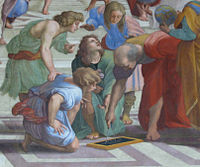Portal:Mathematics
The Mathematics Portal
Mathematics is the study of numbers, quantity, space, structure, and change. Mathematics is used throughout the world as an essential tool in many fields, including natural science, engineering, medicine, and the social sciences. Applied mathematics, the branch of mathematics concerned with application of mathematical knowledge to other fields, inspires and makes use of new mathematical discoveries and sometimes leads to the development of entirely new mathematical disciplines, such as statistics and game theory. Mathematicians also engage in pure mathematics, or mathematics for its own sake, without having any application in mind. There is no clear line separating pure and applied mathematics, and practical applications for what began as pure mathematics are often discovered.
| More about Mathematics... |
Selected article | Selected picture | Did you know... | Topics in mathematics
Categories | WikiProjects | Things you can do | Index | Related portals
There are approximately 31,444 mathematics articles in Wikipedia.
Selected article
The continuum hypothesis is a hypothesis, advanced by Georg Cantor, about the possible sizes of infinite sets. Cantor introduced the concept of cardinality to compare the sizes of infinite sets, and he showed that the set of integers is strictly smaller than the set of real numbers. The continuum hypothesis states the following:
- There is no set whose size is strictly between that of the integers and that of the real numbers.
Or mathematically speaking, noting that the cardinality for the integers  is
is  ("aleph-null") and the cardinality of the real numbers
("aleph-null") and the cardinality of the real numbers  is
is  , the continuum hypothesis says
, the continuum hypothesis says
This is equivalent to:
The real numbers have also been called the continuum, hence the name.
| View all selected articles | Read More... |
Selected picture
Illustration of a failed attempt to comb the "hair" on a ball flat, leaving a tuft sticking out at each pole. The hairy ball theorem of algebraic topology proves that whenever one attempts to comb a hairy ball flat, there will always be at least one tuft of hair at one point on the ball. More precisely, it states that there is no nonvanishing continuous tangent-vector field on an even-dimensional n‑sphere (an ordinary sphere in three-dimensional space is known as a "2-sphere"). This is not true of certain other three-dimensional shapes, such as a torus (doughnut shape) which can be combed flat. The theorem was first stated by Henri Poincaré in the late 19th century, and first proved in 1912 by L. E. J. Brouwer. If one idealizes the wind in the Earth's atmosphere as a tangent-vector field, then the hairy ball theorem implies that given any wind at all on the surface of the Earth, there must at all times be a cyclone somewhere. Note, however, that wind can move vertically in the atmosphere, so the idealized case is not meteorologically sound.
Did you know...
- ...that 9814072356 is the largest square number using each of the digits 1, 2, 3, 4, 5, 6, 7, 8, 9, and 0 exactly once?
- ...there are (19) consecutive prime numbers ending in the digit 1, starting from 253931039382791?
- ...that the Electronic Frontier Foundation funds awards for the discovery of prime numbers beyond certain sizes?
- ...an infinite, nonrepeating decimal can be represented using only the number 1 using continued fractions?
- ...that outstanding mathematician Grigori Perelman was offered a Fields Medal in 2006, in part for his proof of the Poincaré conjecture, which he declined?
- ...that a regular heptagon is the regular polygon with the fewest number of sides which is not constructible with a compass and straightedge?
| Showing 6 items out of 72 | More did you know |
WikiProjects
The Mathematics WikiProject is the center for mathematics-related editing on Wikipedia. Join the discussion on the project's talk page.
Project pages
Essays
Subprojects
Related projects
Things you can do
Categories
Algebra | Arithmetic | Analysis | Complex analysis | Applied mathematics | Calculus | Category theory | Chaos theory | Combinatorics | Dynamic systems | Fractals | Game theory | Geometry | Algebraic geometry | Graph theory | Group theory | Linear algebra | Mathematical logic | Model theory | Multi-dimensional geometry | Number theory | Numerical analysis | Optimization | Order theory | Probability and statistics | Set theory | Statistics | Topology | Algebraic topology | Trigonometry | Linear programming
Mathematics (books) | History of mathematics | Mathematicians | Awards | Education | Institutes and societies | Literature | Notation | Theorems | Proofs | Unsolved problems
Topics in mathematics
| General | Foundations | Number theory | Discrete mathematics |
|---|---|---|---|
|
|
|||
| Algebra | Analysis | Geometry and topology | Applied mathematics |
Index of mathematics articles
| ARTICLE INDEX: | A B C D E F G H I J K L M N O P Q R S T U V W X Y Z 0-9 |
| MATHEMATICIANS: | A B C D E F G H I J K L M N O P Q R S T U V W X Y Z |
Related portals
 |
 |
 |
 |
|
 |
 |
| Algebra | Analysis | Category theory |
Computer science |
Cryptography | Discrete mathematics |
Geometry |
|
|
 |
|
 |
 |
|
|
 |
| Logic | Mathematics | Number theory |
Physics | Science | Set theory | Statistics | Topology |
- What are portals?
- List of portals
- Featured portals





